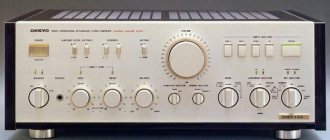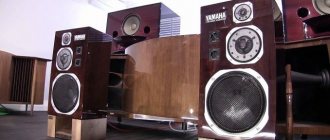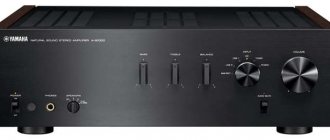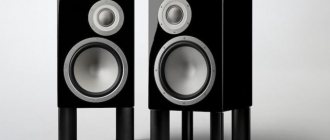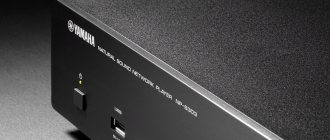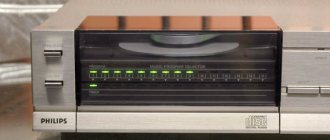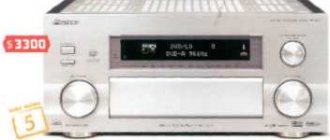Peculiarities
In addition to CD format recordings, this player also plays SACD discs. To reduce mutual interference, the analog and digital circuits of the circuit are powered from separate blocks. The side panels of the case are covered with yellow solid wood overlays, which, either due to their material or color, make the appearance of the device less technical.
The small display displays the most useful information - the track number and playback time, which can be displayed in one of three modes: from the beginning of the track, to the end of the track, and to the end of the disc. The brightness of the symbols is adjustable within four levels, except for the pure audio mode, in which the display is completely turned off.
Using the remote control, you can program the playback order of multiple tracks. The function of playing songs in random order and repeat mode (one track or the entire disc) are also implemented.
The tray moves slowly and completely silently. There are rubber inserts on the surface of the tray, on which the CD is placed, so the disc does not rattle when moving the tray.
A feature of the switching system that not every CD player has is a pair of XLR-type connectors that allow you to output stereo audio using a balanced connection.
Sound
Pop, electronic music. Music quickly arouses keen interest, which is greatly facilitated by the abundance of emerging musical details, the versatility of sound with absolute comfort for hearing at any volume.
Electronic effects and a variety of live exotic instruments, for example, exotic drums, are very organically combined, and the sounds of nature are woven into the musical canvas very harmoniously.
The balance of highs, bass and mids is maintained almost perfectly, the music flows in one homogeneous stream, without noticeable bursts or dips. The player produces enveloping iridescent bass that imperceptibly fills everything around with soft warm waves.
The lower strikes have a high density; even in the mid-bass, the impulses sound deep and prominent, especially for single strikes. You can hear in detail how the drum membrane vibrates, the strike in the upper bass has very resolved after-sounds, it’s even surprising how richly the sound of this, in general, simple instrument is conveyed.
High frequencies are very informative, they are clearly visible, but at the same time they are very consistent: for all their sharpness, the highs never rise above the rest of the sound so much as to cause discomfort. The sounds in the upper middle and top do not put pressure on the ear with either extraneous coloring or excessive detail.
The range of high sounds is very detailed, starting from the upper middle and ending, in fact, with the entire top. The possibilities of the stereo path are enough for the after-sound of strings and metal drums to ring transparently and airily.
The sound is very wide, it goes far beyond the boundaries of the speaker systems, sometimes you get the feeling that the sound space is about to close behind you. Music, on the one hand, relaxes, and on the other hand, captivates with the purity and scale of the sound canvas; sometimes it evokes the feeling of luminous, intertwined, but clearly distinguishable streams of sound.
Rock . The sound is evenly distributed across all frequency ranges. Despite the powerful bass, the mids and tops are not deprived of energy, so even a muffled cymbal sounds very intelligible.
The bass is very detailed, allowing many low-frequency nuances of the music to emerge. The bass sound, in addition to this, is also very clear, so even the fastest bass hits follow each other with relief volumetric impulses, without losing transparency even for a moment. Even an excessive increase in sound volume does not reduce its comfort. No matter how intense the bass playing is, the low vocals remain intelligible against its background.
The middle sounds detailed and sharp, although it cannot be said that the after-sounds are very drawn-out; they are rather collected, neat in nature. In the middle, the following situation is observed: the closer the sound is to the upper range, the more intelligible it becomes, so the ringing of the entire group of metal drums sounds very noticeably and for a long time. Numerous sound details are generously scattered throughout the composition, which clearly appear thanks to the purity of the sound. Fading away in the finale, the composition sounds legible and clear until the very last moment, and does not drown in noise, as often happens.
Rock performed by the Yamaha CD-S2000 sounds perfect, this music conveys energy and gets you going incredibly easily.
Jazz . The record player produces subtle cymbal rings in the background and neatly defined double bass sounds in the mid-bass, this instrument produces its rhythmic pattern with elastic impulses. The sound is not flattened in any range, so the music sounds with an incendiary open flow. Piano notes sound to match the polished playing of the double bass even in the critical areas of the lower middle, but do not lose the naturalness and accuracy of the sound.
The sound of percussive metal is conveyed with vividness. The detail of the sound is so high that you can hear the soundboard of the piano resonating. The vocal performance is warm and open. The palette of the choir is thoroughly conveyed, with all the most distant voices.
There is a feeling that the sound volume can be increased as much as you like - no background noise arises.
Classic . First of all, I would like to note the way the musical scene is conveyed: if you close your eyes, you get the feeling that the walls have opened up, revealing a large, almost tangible space. A large symphony orchestra sounds wide and large. Parts of violas, horns and flutes are localized with crystal clarity, especially if these instruments are soloed. The violins and bass horns are a little less distinct.
In the middle, the sounds of its upper part are most resolved; violas, for example, play more transparently than violins. Impulses are accurately transmitted - the blows of large cymbals and large drums sound thunderous, but not deafening.
This device expands the narrow moments of the compositions so much that you simply stop noticing them: both in the climax and in the prelude, the sound is transmitted equally coherently.
The richness of sound ensures the completeness of musical phrases; all themes of a symphonic work sound equally meaningful.
There is a magical feeling of a real concert hall, when the music, coming off the acoustic systems, begins to come from afar, as if from a real orchestra, although with your mind you understand that where the sound comes from, there is nothing but walls.
Three Musketeers - Pioneer PD-S707, Yamaha CD-2000, Yamaha CDX-2200
I suggest you read a comparison of 3 popular CD players Pioneer PD-S707, Yamaha CD-2000, Yamaha CDX-2200 from our regular participant under the nickname Alex.
We read and share our impressions of what we read in the comments or on our forum. Of course, the glorious times of the musketeers have long since sunk into oblivion and we remember them only thanks to the immortal Alexandre Dumas. But duels - duels remained. Any fight is essentially a duel. Be it a sports competition or a verbal debate. But this is in the world of people. What about the world of technology? Yes, everything is the same: any comparative testing is a battle in which the strongest wins. But at least this battle isn't bloody. Although there is plenty of drama in it too. But we won’t climb into such jungle today. Moreover, the format doesn’t really allow it. So, the current fight will take place on... tuning forks. The fact is that the two participants in the current showdown belong to the glorious Yamaha clan, whose logo is precisely three crossed tuning forks. Well, so that the third tuning fork does not remain idle, we will hand it over to a representative of the no less respected Pioneer clan. Although today he will act more as a second. (well, or an arbitrator) So before us is Yamaha CD - 2000 (1985), Yamaha CDX - 2200 (1986), Pioneer PD - S707 (1998). The year of release of the model is indicated in parentheses, and not the age of specific subjects - it is in The two cases are slightly different.
I’ll say right away that the Pioneer is certainly a good player, but both Yamahas are noticeably higher in class and to level the odds, the Pioneer is used as a transport with an external small-scale (we’ll assume it’s a proprietary) DAC. If you predict the outcome in advance, I hasten to say that not everything is so simple. In general, I don’t set out to determine a specific winner - it’s like in boxing: light weight, middle weight, heavy weight (or light heavyweight, etc.)
Accordingly, all three duelists are of different weight and price categories. In such conditions, only a review test is possible, and not a direct comparison, as they say head-on. To begin with, I’ll briefly tell you about each device, including its advantages and disadvantages. Let's start with the oldest ones. Yamaha CD - 2000 (1985 150,000 - 158,000 yen, the device came in two versions: with side wooden overlays and without them. This probably explains the small price range.)
Yamaha CD-2000
Pros: Beautiful. Sounds convincing enough. Disadvantages: I found two. For me both are significant. First, it does not read self-written blanks (perhaps this is unique to the sample being tested, or perhaps to this model as a whole) And disadvantage number two is that there is no digital output. That is, using the device as a transport with an external DAC will not work. I repeat - these are disadvantages for me. Some may consider them merits. The weight of the device is 8 kg. I had a silver specimen visiting me.
Now it's Yamaha CDX's turn - 2200 (1986 and 168,000 yen). It would seem almost the same. The difference is one year and some ten thousand yen. But it's not that simple. In those years, inflation in Japan was worse than in Russia now, and the yen/dollar exchange rate changed fantastically. 158,000 yen in 1985 is approximately 1,450 dollars, and 168,000 yen in 1986 is already 2,150 dollars. But the difference is not only and not so much in this.
(Note from hifi-audio.ru : the Japanese ignored the external dollar exchange rate, leaving prices in yen unshakable and corresponding to the assigned sound class)
CDX - 2200 is a completely different device. 15 kg. (!!!) weight (versus 8 kg for CD2000). The height and depth also differ noticeably more and, looking ahead, the sound is also completely different. When I first saw this anthracite block, and before that I also dragged it in my hands to the 5th floor, what can I say?
Probably the soldiers of the First World War experienced something similar when they first saw tanks... I have seen quite large vehicles before, perhaps, even certainly, surpassing the Yamaha in size (but not in weight). But this blued aluminum (and the entire body of the Yamaha in a circle is made of it) creates such a monumental composition that if I were Stanislavsky, I would immediately say: I believe!
At least I believe that such a monster can survive not only the First, but also the Third World War... Since the top of the classic Yama CDX - 10000 came out a year later, that is, in 1987, then apparently from the 2200th the transport one migrated to it mechanism, DAC chipset and much more, and not vice versa, as happens most often. Although these are just my assumptions - I will not say that this is exactly what happened in reality.
(Note from hifi-audio.ru : it was so, the cdx-2200 introduced a revolutionary transport system, the principles of which were used in the cdx-10000 model, in turn, the anniversary model 10000 unleashed a race for the number of bits, claiming that its model was 18-bit , based on the peculiar mathematics of adding the bits of two PCM-56 DACs and the bits from a digital filter. All this can be read in the review material History of CD players on CD players on the Yamaha website)
Well, I can’t help but mention the thick network cable (centimeter in diameter) made of oxygen-free copper. In 1986, this did not happen often. I didn’t find any shortcomings for myself in this device, although I tried. Self-written blanks can be read without problems, there is a digital output (although in this case it may not be needed), the device sounds...
However, how it sounds—more on that a little later. The device, as I already said, is black and there are no other color versions in nature.
And finally, Pioneer. Pioneer PD-S707 - European version (the Japanese analogue is supposedly PD-77, but I won’t compare them, although there are differences). The model was produced for quite a long time: from 1998 to 2005. Indirectly, this is a sign of a fairly successful model, although far from top-end. First of all, the transport mechanism is considered successful - many consumers still use devices of this line precisely as transport.
Pioneer PD-S707
But the audio part is quite decent for average high-fi. I cannot compare this device with an authentic factory copy - my copy was upgraded at one time (I think it was quite successful). A second transformer was installed and the power supply for the analog and digital parts was separated. At the output there are Burr-Braun op-amps and audiophile capacitors. As a result, even on its own the device sounds at the level of higher-class models. However, I use it mainly as a transport and the sound is output through an external DAC. Well, now how does it all sound...
Yamaha CD - 2000 has purebred, comfortable sound - you can immediately hear that the device is not from the budget line, but the detail clearly does not reach the established bar - some minor nuances in the recording are not heard as clearly as those of competitors. However, in general, the device is self-sufficient and if you do not place excessive demands on it, it is capable of pleasing the owner with its sound for many (I hope) years to come.
I only remind you about the unreadability of self-written discs (if there was a second such device, one could say with greater certainty that this is a design flaw or defect of the laser on this copy - I am more inclined to the first, because the player swallows ANY factory discs with ease. Including scratched ones) Well, the lack of a digital output may confuse some. Although the device is of a fairly high level and a budget external DAC is unlikely to improve its sound. And for an expensive DAC and transport it makes sense to select a comparable level. Although in life everything is not so simple and the path of building a system cannot be adjusted to a pre-drawn and verified schedule. There are sometimes many more accidents (pleasant and not so pleasant) on this very path than in life itself.
Yamaha CDX - 2200 You turn on a thirty-year-old device and the first thing that comes to mind is that all these years progress has stood still. It’s very difficult to name a modern player from the mass segment offhand that would play better than a thirty-year veteran. Personally, not a single model came to mind. CDX - 2200 is of a noticeably higher level than CD - 2000. It sounds richer in timbre and the resolution is of a very high level. I'm not even talking about appearance and design. Surely it would have had worthy rivals among players from other companies from that era, but now I listen and compare what is available at the moment. And at the moment the leader is definitely CDX - 2200. But only as a standalone player.
What about Pioneer? This is where the most interesting thing is. As a pure loser, he expectedly lost to both Yamahas - the 2000 - just a little, and the gap with the 2200 is more noticeable in favor of the latter. But this is not surprising. Despite the upgrade, competing with top-end devices on equal terms is an impossible task. However, as soon as we turned on “Pioneer” through the DAC, the picture changed dramatically. Pioneer won back the lost points and quite easily overtook the 2000 Yamaha, almost catching up with the 2200.
And here all sorts of nuances began - it’s difficult to say for sure which of the two devices reached the finish line first. Yes, in general, this is probably useless. I didn’t try to identify an unconditional winner - I just tried to compare two concepts: a CD player on its own versus a CD transport plus a DAC. Of course, the comparison is incorrect either in terms of financial or time criteria.
Currently, on the secondary market, a Yamaha CDIX-2200 costs from 25 to 45 thousand rubles (I don’t think there is any need to explain what such a price range depends on). A non-new Pioneer - 707 can be found for 10 - 15 thousand. But with the DAC, everything is not so simple - the last copies of the DAC, one of which I have, was sold by the manufacturer for 70 thousand. I bought mine for another 30. True, this was a few years ago. Back then, these 30 thousand rubles were equal to a thousand dollars. So if the potential owner doesn’t want to bother with DACs and wires, it probably makes sense to buy a Yamaha 2200 or something similar.
Yamaha CDX-10000 - Uncompromising Perfection
If a person has several devices and wants to bring their sound to some common denominator, a DAC is a completely reasonable, albeit not the cheapest, solution. I'm talking about a good DAC. As for me personally, the “Pioneer” + DAC combination still more than suits me. In any case, the DAC will remain in my system and possibly for a long time. Do I want a Yamaha 2200? Yes I want to. Even if this desire is not entirely justified. If financial problems are resolved in a positive way in the near future, then the 2200th will move into my apartment. Moreover, the owner now has two identical copies for sale. If not, I will remember this device with warm feelings and hope to meet something even more interesting.
And one more thing... If this review was written for some women's magazine, I would probably compare all the subjects with famous movie characters: Yamaha CD - 2000 - Stirlitz (Vyacheslav Tikhonov) from "Seventeen Moments of Spring" - under a strict uniform and a cold Nordic appearance there is almost human soul. Yamaha CDX - 2200 - McMurphy (Jack Nicholson) “One Flew Over the Cuckoo's Nest” - Brutal, charismatic to the point of disgrace (in a good way) - he seems to shout: That’s who I am! Accept it or not, but I won’t become anyone else. And at least you won’t get bored with me. Well, Pioneer PD - S707 is... well, let's say Sergei Bezrukov - relatively young, but no less talented, albeit with minor reservations. But since I write for a different audience and by and large there are no women in it, then for the stronger half of humanity I think everything is more or less clear even without the last paragraph.
